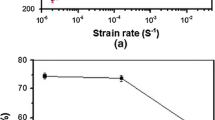Abstract
The mechanical properties of the Ll2-type intermetallic compound Ni2(Al0.4,Mn0.6), which exhibited enough deformability accompanied with the positive temperature dependence of yield stress, were examined from the point of view of its susceptibility to hydrogen embrittlement. Remarkable and moderate increases of elongation and ultimate tensile strength were observed by evacuating and with increasing strain rate, respectively, although the yield stress was almost constant independent of not only testing environment but also strain rate. On the other hand, the cathodically precharged hydrogen showed deteriorated elongations while the baking treatment resulted in restoration of elongation. Fractographic observation revealed the expected correlation between elongation and fracture mode; with increasing elongation the transgranularly fractured region increased. From this result, it is suggested that hydrogen can be removed from the specimen interior by evacuating or baking, and also that hydrogen can be injected from the sample surface by hydrogen charging; that is to say, hydrogen permeation is almost reversible for both processes. It is thus concluded that the present alloy has severe hydrogen embrittlement susceptibility, both from the residual hydrogen in the specimens as well as from that penetrated from the environment.
Similar content being viewed by others
References
D.P. Pope and S.S. Ezz:Int. Metals Review, 1984, vol. 29, pp. 136–67.
N. Masahashi, T. Takasugi, and O. Izumi:Metall. Trans. A, 1988, vol. 19A, pp. 345–52.
A. K. Kuruvilla, S. Ashok, and N. S. Stoloff:Proc. Third. Int. Con- gress on Hydrogen in Metals, Paris, Pergamon Press, 1982, vol. 2, p. 629.
B.J. Berkowitz and C. Miller:Metall. Trans. A, 1980, vol. UA, pp. 1877–81.
A.K. Kuruvilla and N. S. Stoloff:Scripta Metall., 1985, vol. 19, pp. 83–87.
T. Takasugi and O. Izumi:Scripta Metall., 1985, vol. 19, pp. 903–07.
T. Takasugi and O. Izumi:Acta Metall., 1986, vol. 34, pp. 607–18.
C.T. Liu:Int. Metals Review, 1984, vol. 29, pp. 168–94.
J.T. Brown and W. M. Baldwin, Jr.: Trans. AIME, 1954, vol. 200. pp. 298–303.
H. H. Johnson, J. G. Morlet, and A. R. Troiano: Trans. AIME, 1958. vol. 212, pp. 528–36.
Author information
Authors and Affiliations
Additional information
formerly Graduate Student with Tohoku University, Sendai, Japan,
Rights and permissions
About this article
Cite this article
Masahashi, N., Takasugi, T. & Izumi, O. Hydrogen embrittlement of pseudobinary l12-type Ni3(Alo.4Mno.6) intermetallic compound. Metall Trans A 19, 353–358 (1988). https://doi.org/10.1007/BF02652545
Received:
Issue Date:
DOI: https://doi.org/10.1007/BF02652545




